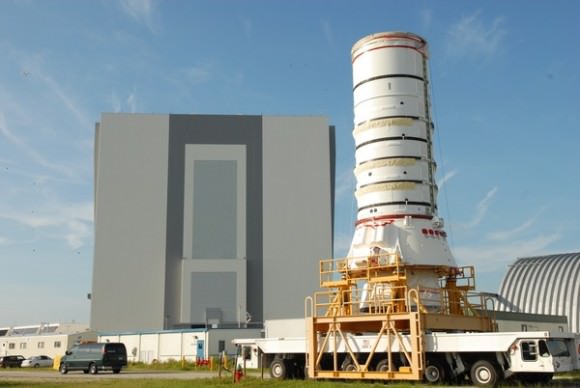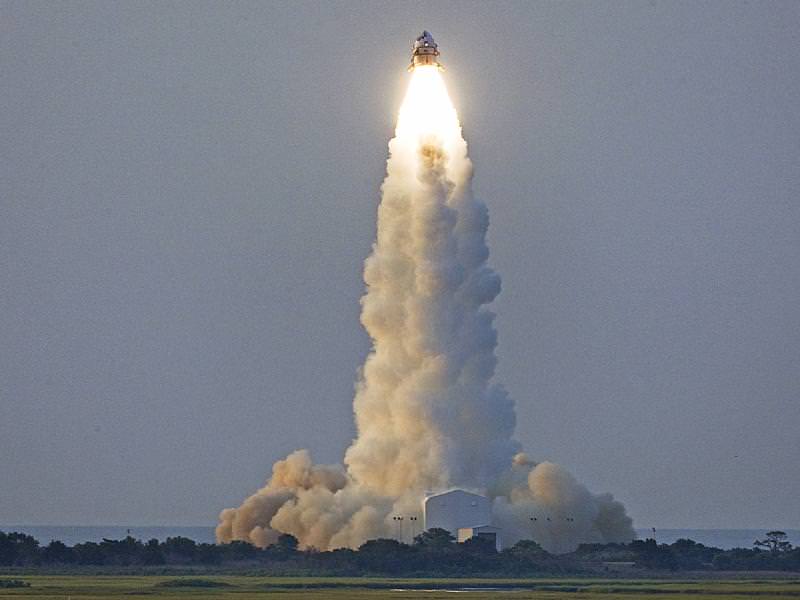[/caption]
While the Constellation program is undergoing design reviews, NASA conducted a successful test on an alternative abort system for the Orion spacecraft to provide options and additional data on how to best protect astronauts in the event of a problem on the launch pad or during ascent. A simulated launch of the Max Launch Abort System, or MLAS, took place Wednesday morning at 6:26 a.m. EDT at NASA’s Wallops Flight Facility, Wallops Island, Va. The 10 meter high (33-feet) MLAS vehicle was launched to an altitude of about 1.5 km (1 mile)to simulate an emergency on the launch pad. A mock-up of the Orion crew vehicle successfully separated from the launch vehicle seven seconds into the flight and parachuted into the Atlantic Ocean. While there were some concerns about the various pieces of the MLAS possibly hitting each other, the test went without a hitch.
Meanwhile, the Ares I-X rocket is in the process of being “stacked” for a test flight later this summer.

NASA’s first choice for the escape pod is the LAS, or Launch Abort System, which has a single solid launch abort motor in a tower mounted at the top of the launch vehicle stack of the Orion and Ares I rocket. The LAS will be capable of automatically separating the spacecraft from the rocket at a moment’s notice to make possible a safe landing.
Today’s launch was a technology demonstration, and the MLAS is not intended to be a replacement for the LAS.
Read our previous article about test of the LAS
NASA says the data from today’s MLAS pad abort test is helpful in several ways for the Constellation program. MLAS is the first demonstration of a passively-stabilized launch abort system on a vehicle in this size and weight class. It is the first attempt to acquire full-scale aero-acoustic data — the measurement of high loads on a vehicle moving through the atmosphere at high velocity — from a faired capsule in flight. The test is also the first to demonstrate full scale fairing and crew module separation and collect associated aerodynamic and orientation data.
UPDATE: Here’s the video of the launch — the first part is a preview, and the launch stuff starts about 2:00 minutes in:
Source: NASA


Nancy, thanks for some of the details mentioned in your article. What with at least 2 alternative proposals ( i.e. Shuttle-Derived launch vehicles and the Jupiter v2.0 ), strapping the (now 2 man capsule Orion) near the top of the external tank and outfitting it with an advanced emergency escape rocket that could be used in the event of a a launch abort seems sensible and at a more palatable price tag. And no need for major launch pad modifications will be needed. UT just ran a story for the Shuttle Derived Heavy Lift alternative here: http://www.universetoday.com/2009/07/01/faster-cheaper-and-better-way-to-the-moon/ . Their case that they made both seem prudent and MUCH less expensive than the current Constellation project. I can see this as a tested system that will still be man rated and be configured to deliver equipment to the moon. But, the Orion capsule will have many advances compared to the Command Module in the Apollo program.
This is a much better system than the tower based LAS, I am a fan of it… but I wouldn’t use it next to a fuel tank.
It brings the exhaust even closer to things that don’t want to be warm.
Besides, if what Bolden said about his interest in the vasimir is true (please, please, oh please, I WANT TO BELIEVE!) then we’re looking at orbiting some serious hardware for both the Moon and Mars.
An SLDV simply wont do in a game where HLV’s are barely adequate anymore.
Someone needs to dig up the plans for Nova.
Aagh! I can’t believe that NASA still is spinning off “alternate-but-not-used technologies” when they have the need for focus on the economy, and strategy, at hand!
Even if they would be politically over-ruled, a very remote possibility (read: no way it’s going to happen – unless they change the game, say by focusing on NEOs and Mars moons as new and still important places to go), these things are a far cry from being the immediate replacement.
And if it’s an effort to keep the existing R&D happy while waiting for something tangible out of the politically narrowed and prolonged pipe, it’s just pitiable.
Why is NASA testing something that won’t be used, and when an acceptable alternative already exists?
“Today’s launch was a technology demonstration, and the MLAS is not intended to be a replacement for the LAS. ”
READ: Todays launch was a colossal waste.